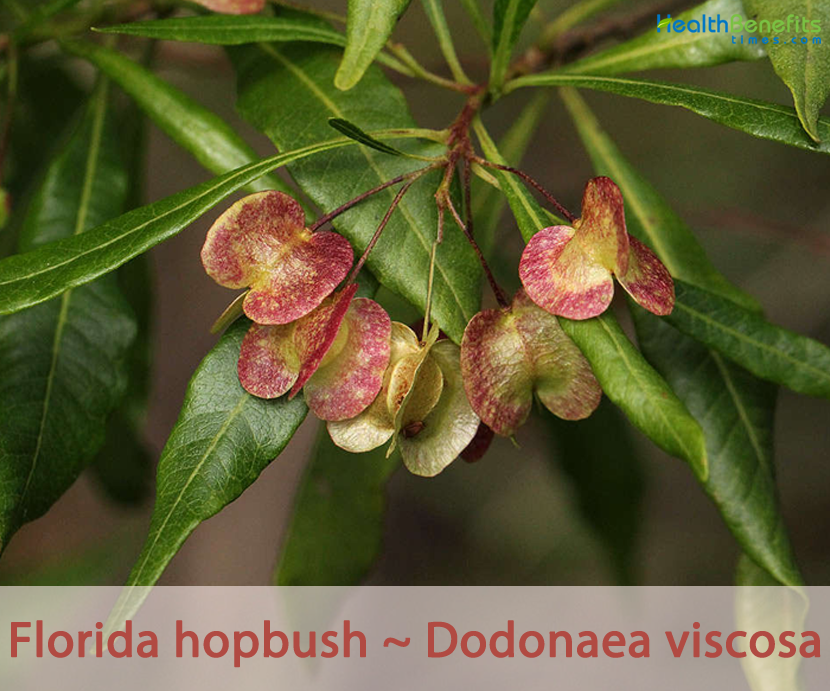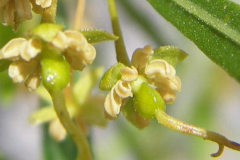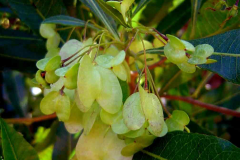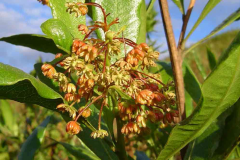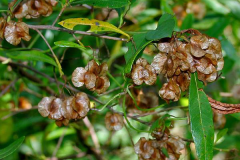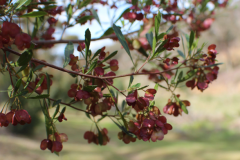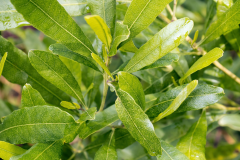| Florida hopbush Quick Facts | |
|---|---|
| Name: | Florida hopbush |
| Scientific Name: | Dodonaea viscosa |
| Origin | Australia but it occurs throughout the tropics and subtropics, widely distributed in temperate regions of Australia, Africa, Mexico, New Zealand, India, Northern Mariana Islands, Virgin Islands, Florida, Arizona, South America and elsewhere. |
| Colors | Initially green turning to red ripening brown |
| Shapes | 2–3-winged papery capsule, 15–23 mm long and 18–25 mm wide, dehiscent by splitting along 2–3 central septa, each cell 2-seeded. |
| Health benefits | Antimicrobial properties, Antioxidant and anti-cholinesterase activities, Treat cancer, Treat skin disease, Good for oral, Repel mosquitoes and treat malaria, Manage diabetes, Treat diarrhea and relax muscles, Gastro-protective properties, Treat inflammation, Treat organ injury, Treat gout and rheumatism |
| Name | Florida hopbush |
|---|---|
| Scientific Name | Dodonaea viscosa |
| Native | Believed to be Australia, but it occurs throughout the tropics and subtropics, widely distributed in temperate regions of Australia, Africa, Mexico, New Zealand, India, Northern Mariana Islands, Virgin Islands, Florida, Arizona, South America and elsewhere. |
| Common Names | Native Hops, Florida hopbush, Hopseed Bush, Varnish Leaf, Hopbush, Narrow-leaf hopbush, Wedge-leaf hop bush, broad leaf hopbush, candlewood, giant hopbush, sticky hopbush, native hop bush, soap wood, switch sorrel, aalii |
| Name in Other Languages | Afghanistan: Ghoraskai Afrikaans: Sandolien, Gansies, Kankerbos Arabic: Shathu dabiq (شث دابق), Dodonia, Daidon, Dodanaia, Shath Argentina: Chirca, chamiso Australian: Broad leaf hopbush, candlewood, giant hopbush, narrow leaf hopbush, sticky hopbush, native hop bush, soapwood, switchsorrel, wedge leaf hopbush, native hop Bahamas: Candlewood Brazil: Erva-de-veado, faxina-vermelha, faxino-vermelho, vassoura, vassoura-do-campo, vassourao, vassoura-vermelha, vassourinha-do-mato Bolivia: Ch’akatea Brazil: Vassoura vermelha China: Po liu (坡柳), Ming you zi (明油子), Che sang zi (车桑子), Kuruma kuwako (車桑子), Chē sāng zǐ yè (车桑子叶), Duǎn guān dōngfēng cài (短冠东风菜), Chē sāngzi gēn (车桑子根) Colombia: Hayuelo Dominican Republic: Cucaracha, granadillo, palo de reina, palo de rey Dutch: Kleverige hopstruik Czech: Dodonka žláznatá English: Hopseed, hop seed bush, Florida hopbush, Broadleaf hopbush, Giant hopbush, Hopbush, Hopseed bush, Hop shrub, Sticky hopbush, Purple Hop-Bush, Jamaica dogwood, Broad-leaved hopbush, varnish leaf, sand olive, switch sorrel, candlewood, native hopbush, soap wood, ake-ake, Florida hopbush Finnish: Humala-akea French: Dodonée visqueuse, bois de reinette, bois d’arnette, dodonée visqueuse German: Felsenweide Guam: Lampuaye Haiti: Menglier petites feuilles, pativier Hawaiian: Aʻaliʻi, ‘a‘ali‘i-ku ma kua, ‘a‘ali‘i ku makani Hebrew: Dodonaea dvika, דודוני, דודונאה דביקה Hindi: Sinatha, Vilayti Mehdi, Walaytinahndi, Sanatta, Vilāyatī mēhandī (विलायती मेहॆंदी) India: Banda, Aliar, Vilayati mehandi, jakhmi, lutchmi, paorki, pulivavila, sanatta, vrali Indonesia: Cantigi, Kayu mesen, Sikil Irula: Manthiri chedi Japanese: Hauchiwanoki (ハウチワノキ) Kannada: Bandaru, Bandarike (ಬಂದರಿಕೆ), Hangarike (ಹಂಗರಿಕೆ), Hengarulu (ಹೆಂಗರುಳು), Bandare, Bhandaru, Andaru giḍa (ಅಂದರು ಗಿಡ) Kenya: Mkaa-pwani, msidu, tabilikuet, tibilikwa Kinyarwanda: Musaya, Umusasa, Umusembia Malayalam: Vrali (വ്രാളി), Unnataruvi, Aattotta, Krali, Unnatharuvi, Unnatharuvi, Virali Malaysia: Kayu berteh, Serengan laut, Gelam paya Manipuri: Bilaiti mehendi Marathi: Lutchmi Mexico: Romerillo, granadina, grenadine, jarilla, ocotillo, pirimu Myanmar: Hmaing New Zealand: Akeake Oriya: Mohra Pakistan: Sanatha, jatchmi Palau: Mesechelangel, Lokai, Kelne, Ioia Philippines: Dumánai, haguiui, kalapinai Portuguese: Faxina-vermelha, vassourão-vermelho, vassoura-do-campo, vassoura-vermelha Puerto Rico: Chamiso Quechua: Ch’akatiya Rundi: Umusara Russian: Dodoneya lipkaya (додонея липкая) Sanskrit: Aliar, rasna, sanatta Seri: Casol caacol Seychelles: Bois de reinette Somalia: Xayramad South Africa: Sand olive, sandolien Spanish: Vrali, chirca de monte, dodonea, hayuelo, chamana Swedish: Mkaa pwani, mkengata Tamil: Virali (விராலி), Vilaari, Viraali Telugu: Bandaru, Pullena Thailand: Chumhet le, Mai pek, Tảs̄eā h̄nū (ตำเสาหนู) Uruguay: Chamiso Vietnam: Ch[af]nh r[af]ng, R[uf] r[if] |
| Plant Growth Habit | Dioecious or monoecious dense or erect, multi-stemmed, spreading, evergreen shrub or single-stemmed small tree |
| Growing Climates | Forest margins, savannahs, coastal vegetation on or behind sandy beaches, dry rocky slopes, in canyons, grassy savannas, coastal hammocks, lowland forest, dune fields, boulder beaches through coastal scrub, lowland forest and rocky, stony or sandy soils in the montane zone of Victoria |
| Soil | Prefers light (sandy) soils and requires well-drained soil. The plant prefers acid, neutral and basic (alkaline) soils. It cannot grow in the shade. It requires dry or moist soil and can tolerate drought. The plant can tolerate maritime exposure. It can tolerate atmospheric pollution. It favors areas that receive full sun and is often cultivated in loamy or sandy soils |
| Plant Size | Up to 1–3 m (3.3–9.8 ft) tall, rarely a small tree to 9 m (30 ft) tall and bole can be 15 – 25cm in diameter |
| Bark | Blackish, of variable roughness, thin and exfoliating in long thin strips; twigs blackish or reddish-brown, glandular, developing vertical fissures, uppermost part of young branches greenish and prominently angled |
| Leaf | Leaves are alternate, oblanceolate, 4.0 to 12 centimeters long, 2.5 to 3 centimeters wide, with entire margins, glabrous, sticky when young |
| Flowering season | February to October; August to November in Florida |
| Flower | Flowers are yellowish to greenish yellow, very small, borne on terminal short racemes. Sepals are 3 to 4, oblong. Petals are absent. |
| Fruit Shape & Size | Rounded, membranous, somewhat two-lobed, about 18 millimeters across, including the two wings. Wings are very thin, rounded, about 12 millimeters long. |
| Fruit Color | Initially green turning to red ripening brown |
| Seed | Seeds are dark brown or black |
| Season | November – April |
| Plant Parts Used | Seeds, leaves, bark, Wood, fruits |
| Health Benefits |
|
| Precautions |
|
Plant Description
Florida hopbush is a dioecious or monoecious, dense or erect, multi-stemmed, spreading, evergreen shrub or single-stemmed small tree that normally grows up to 1–3 m (3.3–9.8 ft) tall, rarely a small tree to 9 m (30 ft) tall and bole can be 15 – 25cm in diameter. The plant is found growing in forest margins, savannahs, and coastal vegetation on or behind sandy beaches, dry rocky slopes, in canyons, grassy savannas, coastal hammocks, lowland forest, dune fields, and boulder beaches through coastal scrub, lowland forest and rocky, stony or sandy soils in the montane zone of Victoria. It prefers light (sandy) soils and requires well-drained soil. The plant prefers acid, neutral and basic (alkaline) soils. It cannot grow in the shade. It requires dry or moist soil and can tolerate drought. The plant can tolerate maritime exposure. It can tolerate atmospheric pollution. It favors areas that receive full sun and is often cultivated in loamy or sandy soils.
Bark
Bark is blackish, of variable roughness, thin and exfoliating in long thin strips. Twigs are blackish or reddish-brown, glandular, developing vertical fissures, uppermost part of young branches greenish and prominently angled.
Leaves
The leaves are variable in shape: generally obovate but some of them are lanceolate, often sessile, 4–7.5 cm (1.6–3.0 in) long and 1–1.5 cm (0.39–0.59 in) broad, alternate in arrangement, and secrete a resinous substance. Many specimens have a pointed or rounded apex. Leaf base is extended. Leaf texture is leathery, tough, but also pliable. Midribs are medium becoming less visible close to the apex. Secondary veins are thin, generally indistinct; Veins: often 6 to 10 pairs, indifferently opposite, sub opposite, and alternate, camptodrome. Venation branches from the midrib at different angles, which may vary from 12° to 70°. The basal veins are very ascending in some plants: the angle of divergence may be close to 45°. The basal secondary venation branches from a point near the base of the main vein and becomes parallel with the leaf margin, with the distance of 1 millimeter to 2 millimeters from the edges. Margins are usually toothed or undulating. The remaining secondary veins lay at regular intervals with flowers usually growing at the branches’ ends.
| Leaf arrangement | Alternate |
| Leaf type | Simple |
| Leaf margin | Entire |
| Leaf shape | Oblanceolate; obovate; spatulate |
| Leaf venation | Pinnate |
| Leaf type and persistence | Evergreen |
| Leaf blade length | 4 to 8 inches |
| Leaf color | Green |
| Fall color | No fall color change |
| Fall characteristic | Not showy |
Flowers
Inflorescence is a loose thyrsoid panicle at the end of twigs. The flowers are yellow to orange-red and produced in panicles about 2.5 cm (0.98 in) in length. The flowers may be bisexual or unisexual, and one plant bears either male or female flowers. However, sometimes they are observed to bear flowers of both sexes. The pollen is transported by anemophily. Sepals 3–4, free, 2–2.5 mm long; petals absent; stamens 7(–9), filaments very short, anthers oblong, up to 3 mm long in male flowers, up to 2 mm long in bisexual flowers and reduced to staminodes or completely lacking in female flowers; ovary superior, oblong in outline, flattened, 2–3-celled, strongly rudimentary in male flowers, style 2–3-lobed. It is believed that the flowers lack petals during evolution to increase exposure to the wind. Flowering normally takes place in between February to October while August to November in Florida.
| Flower color | Yellow |
| Flower characteristic | Summer flowering; fall flowering; spring flowering |
Fruits
Fertile flowers are followed by 2–3-winged papery capsule, 15–23 mm long and 18–25 mm wide, white or straw-colored to brown or purplish, dehiscent by splitting along 2–3 central septa, each cell 2-seeded. Seeds are sub globose, more or less compressed, 3 mm in diameter, black.
| Fruit shape | Pod or pod-like |
| Fruit length | 0.5 to 1 inch |
| Fruit cover | Dry or hard |
| Fruit color | Green; red; yellow |
| Fruit characteristic | Showy |
Health benefits of Florida hopbush
Listed below are some of the well-known health benefits of using Florida hopbush
1. Antimicrobial properties
Florida hopbush consists of penta hydroxyl flavone and hautriwaic acid that fights against different bacteria. This plant shows antimicrobial activity against Bacillus subtilis, Micrococcus luteus, Escherichia coli, Salmonella typhi, and Pseudomonas aeruginosa. It also prevents the growth of Streptococcus pyogenes, Staphylococcus aureus, and viruses like Coxsackievirus B3 and influenza A virus.
2. Antioxidant and anti-cholinesterase activities
Antioxidants such as clerodane diterpenoids and phenolics from the plant prevent the activity of an enzyme that causes brain damage. Thus, this plant may slow the progress of Alzheimer’s disease and minimize neuronal degeneration.
3. Treat cancer
Florida hopbush is rich in dodonaeasides A and B, triterpenoid, and saponins. These compounds may slow the progression of cancers like breast cancer, ovary cancer, prostate cancer, and colon cancer. This plant also encourages apoptosis and may be useful as a candidate in chemo to fight against other tumors.
4. Treat skin disease
Florida hopbush consists of bioactive compounds that fight against fungi like Aspergillus niger, Aspergillus flavus, Paecilomyces varioti, Microsporum gypseum, and Trichophyton rubrum. These fungi may cause skin diseases. It also contains Dodoviscin A compound that helps to treat darker patches in human skin by inhibiting melanin synthesis.
5. Good for oral
Florida hopbush as a mouth rinse, gel, or toothpaste fights against the germs of the mouth like Streptococcus mutans and Porphyromonas gingivalis. This plant inhibits the production of acid and proteinase by germs. Thus treat dental caries and periodontal diseases. Furthermore, it contains phytosterol and tannins that damage the cell wall of yeast called Candida albicans. Thus, treats oral candidiasis (thrush and denture stomatitis) within 30 seconds.
6. Repel mosquitoes and treat malaria
Florida hopbush contains diterpenoids and flavonoids that kill the larvae of Aedes albopictus and Culex pipens quinquefasciatus. Its leaves contain pinocembrin that suppresses the growth of Plasmodium parasites thus treating malaria.
7. Manage diabetes
Intake of Florida hopbush reduces blood glucose, serum insulin, and lipid abnormalities. Also, improve glucose tolerance and good cholesterol levels. Thus this plant decreases oxidative stress by improving endogenous antioxidants and treating diabetes.
8. Treat diarrhea and relax muscles
Florida hopbush consists of bioactive compounds which act as an antispasmodic and anti-motility agent. This plant can lower the incidence of tummy, muscle spasms and delay the frequency of diarrhea.
9. Gastro-protective properties
Ingestion of Florida hopbush decreases the amount of acid in gastric juice and prevents the chance of an ulcer. It contains flavonoids, saponins, and phenols which inhibit gastric injury.
10. Treat inflammation
Florida hopbush leaves are a rich source of terpenes and hautriwaic acid that minimize the progression of swelling. Thus, this plant reduces several chronic degenerative diseases like cancer, diabetes, and hypertension.
11. Treat organ injury
Hautriwaic acid found in the Florida hopbush prevents liver damage caused by chemicals and Mycobacterium tuberculosis. It contains antioxidants like flavonoids, phenols, and Fatty acids, mainly oleic acid that treats liver and multiple organs injuries.
12. Treat gout and rheumatism
Florida hopbush leaves may reduce pain, swelling, and stiffness of the joints. Thus this plant leaves in the treatment of gout and rheumatism
Traditional uses and benefits of Florida hopbush
- In Taiwan and Palau the leave are used as a remedy for fever.
- In the Philippines a decoction of the bark serves as an astringent applied to treat eczema and simple ulcers, also used as a febrifuge.
- Leaves are anodyne, astringent, diaphoretic, febrifuge, odontalgic and vulnerary.
- Externally, they are used to treat toothache, sore throats, wounds, skin rashes and stings.
- Leaves are apparently effective in the treatment of toothache if they are chewed without swallowing the juice.
- Bark is used in astringent baths and poultices.
- Its leaves may also be used as plasters for wounds.
- It was also used to stimulate lactation in mothers, as a dysentery treatment, to cure digestive system disorders, skin problems and rheumatism in Africa and Asia.
- Stem or leaf infusions are used to treat sore throats.
- Root infusions to treat colds.
- The stems and leaves are used to treat fever, and seeds (in combination with those of other plants and coated in honey) to treat malaria.
- Stems are used as fumigants to treat rheumatism.
- Leaves are used to relieve itching, and a lotion made from unspecified plant parts to treat sprains, bruises, burns and wounds.
- Digestive system disorders, including indigestion, ulcers, diarrhea and constipation are commonly treated in traditional medicine with an orally-administered decoction of either the leaves or roots.
- Trachoma is treated with applications of leaf juice.
- Pulverized roots are a component of anthelmintic preparations.
- Roots, either in decoction or fresh, are taken by women in East Africa to stimulate milk production after giving birth and to treat dysmenorrhea and irregular menstruation.
- In Ethiopia women make an amulet of Florida hopbush and other plants wrapped in red silk thread and worn around the thigh to ward off infertility.
- Decoction of bark is used as effective astringent for humid eczema and simple ulcers in Philippines.
- In Ethiopia, it is used for skin diseases.
- Decoction is used for flatulent colic and as purgative.
- In La Reunion, it is used for gout and rheumatism. Also, used in baths and fomentations.
- Powdered leaves are applied on wounds which would then heal without scars.
- In India, it is used for headaches, backaches, stomach pains, piles and simple ulcers.
- Leaves are used in treatment of rheumatism, gout, hemorrhoids, fractures, and snake bites.
- Australian aborigines chew leaves for relief of toothache.
- Chewed leaf pulp is used as binding wads for jelly fish and stonefish stings.
- Smoked leafy branches are used for flu-like fever and body aches, and for loosening phlegm.
- In Papua New Guinea, leaves are used by women to become sterile.
- Heated leaves are made into a poultice for boils and sores.
- Bark decoction is drunk to treat dysentery.
- Young leaves are soaked in hot water and the water used to massage the body to relieve body pain.
- Florida hopbush was used in the treatment of rheumatism, skin infections, diarrhea, stomach aches, pains of hepatic or splenic origin, uterine colic and other disorders involving smooth muscles, antipruritic in skin rashes, dermatitis, hemorrhoids and sore throat.
- It is generally administered orally or as poultice to treat a great variety of ailments, but especially fevers and as a poultice to treat wounds, swellings etc.
- The powdered leaves are given to expel roundworms.
- Seeds coated in honey and combined with those of other plants, are used to treat malaria.
- Leaves have pain-killing, wound healing and diaphoretic (sweat-promoting) qualities as well as being astringent and useful for skin rashes, toothache and sore throats.
- Decoction made from new leaf tips or young leaves are used internally for fevers, colds, coughs, influenza, arthritis, asthma, stomach troubles (it relax smooth muscles), diarrhea, ulcers, measles, headaches and to induce sweating but caution is necessary as plant contain small amounts of cyanogenic toxins that may cause cyanide poisoning.
- Leaves, fruits, stems and bark can be used for preparations of baths, good for skin infections, sciatica, candida infections and venereal diseases.
- Brazilians apply sap on tumors.
- In southern part of India, seeds are grounded with black pepper and used to induce sterility in women.
Culinary Uses
- Chewed leaves are said to be stimulating but they contain saponins and are also said to be slightly cyanogenic so their use is not very advisable.
- Fruits are used in pot-pourri in the past.
- They have been used as a substitute for hops in yeast production and beer making in Iraq and Australia.
Other Facts
- The leaves contain up to 18 % tannin.
- Plants are very tolerant of pruning and make a good hedging plant for windy sites.
- Wood is heavy, tough, resistant and used for wedges, hammers, turnery, inlay, cabinets etc.
- The Māori have traditionally used it for making weapons, carved walking staves, axe-handles, and weights on drill shafts.
- It is used by the people from the western part of the island of New Guinea, Southeast Asia, West Africa and Brazil for house building and as firewood.
- It can be used for dune stabilization, remediation of polluted lands and for reforestation.
- Plant is tolerant to strong winds, and therefore is commonly used as hedge, windbreak, and decorative shrub.
- Wood is used for tool handles, tools, brooms, digging sticks, spears, clubs and poles; when available in large sizes, also for posts and frames for permanent structures and in Kenya to make ribs of dhows.
- It is an important source of fuel wood.
- In East Africa it is favored for the production of charcoal.
- In some areas twigs are used as toothbrushes.
- It is used in reforestation, reclamation of marshes and degraded land, and as a soil stabilizer.
- It makes a good live fence for dry areas and is planted as a windbreak.
- It is commonly cultivated as an ornamental throughout its range on account of its abundant fruiting and glossy leaves.
- Leaves and fruits are used in making garlands.
- It makes a sturdy hedge that withstands clipping and is amenable to topiary work.
- In tropical Africa it is browsed by livestock and camels and used as an emergency fodder during the dry season.
- It is a source of nectar and pollen for honey.
- The seeds yield a fish poison.
- Twigs can be used to make a number of dyes – pale green, yellow green and bright gold.
- Leaves and the seed were used by the Maori to make a kind of perfume.
- In New Guinea, people use it as incense for funerals.
References:
https://www.itis.gov/servlet/SingleRpt/SingleRpt?search_topic=TSN&search_value=28675#null
https://pfaf.org/user/Plant.aspx?LatinName=Dodonaea+viscosa
http://www.theplantlist.org/tpl1.1/record/kew-2774037
https://en.wikipedia.org/wiki/Dodonaea_viscosa
https://uses.plantnet-project.org/en/Dodonaea_viscosa_(PROTA)
http://www.stuartxchange.com/Kalapinai.html
http://www.flowersofindia.net/catalog/slides/Hop%20Bush.html
https://indiabiodiversity.org/species/show/10948
https://edis.ifas.ufl.edu/publication/FP181
https://gd.eppo.int/taxon/DODVI
http://www.iosrphr.org/papers/v7i2V1/B0702011021.pdf
https://plants.usda.gov/home/classification/93699
https://tropical.theferns.info/viewtropical.php?id=Dodonaea+viscosa
https://www.cabi.org/isc/datasheet/19449
https://plants.usda.gov/home/plantProfile?symbol=DOVI


